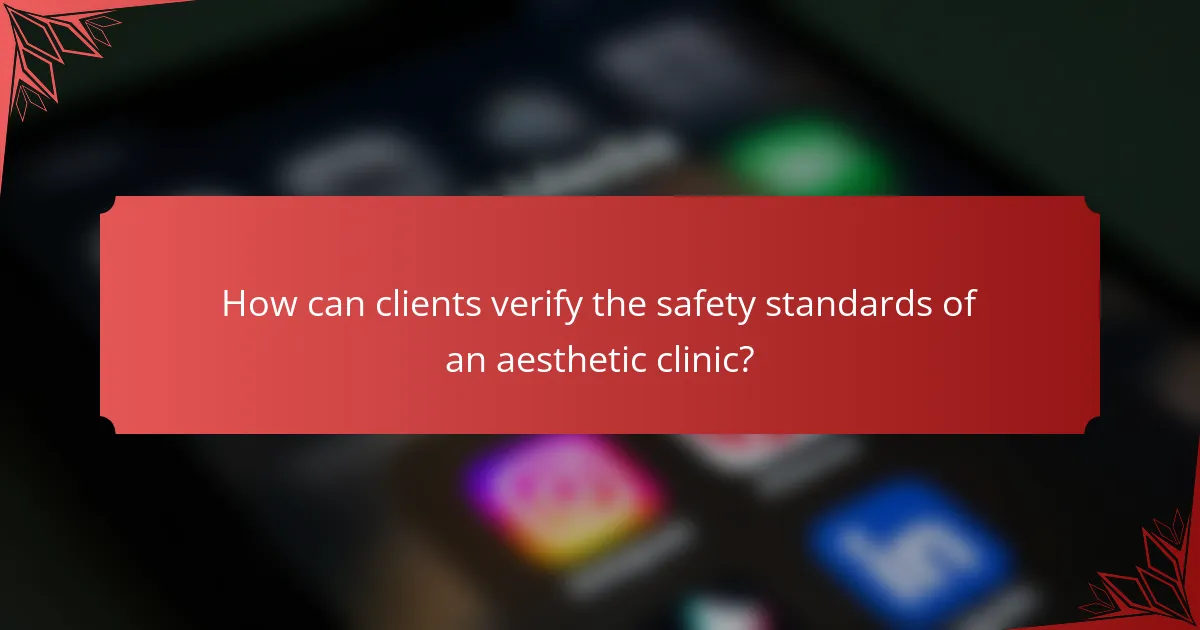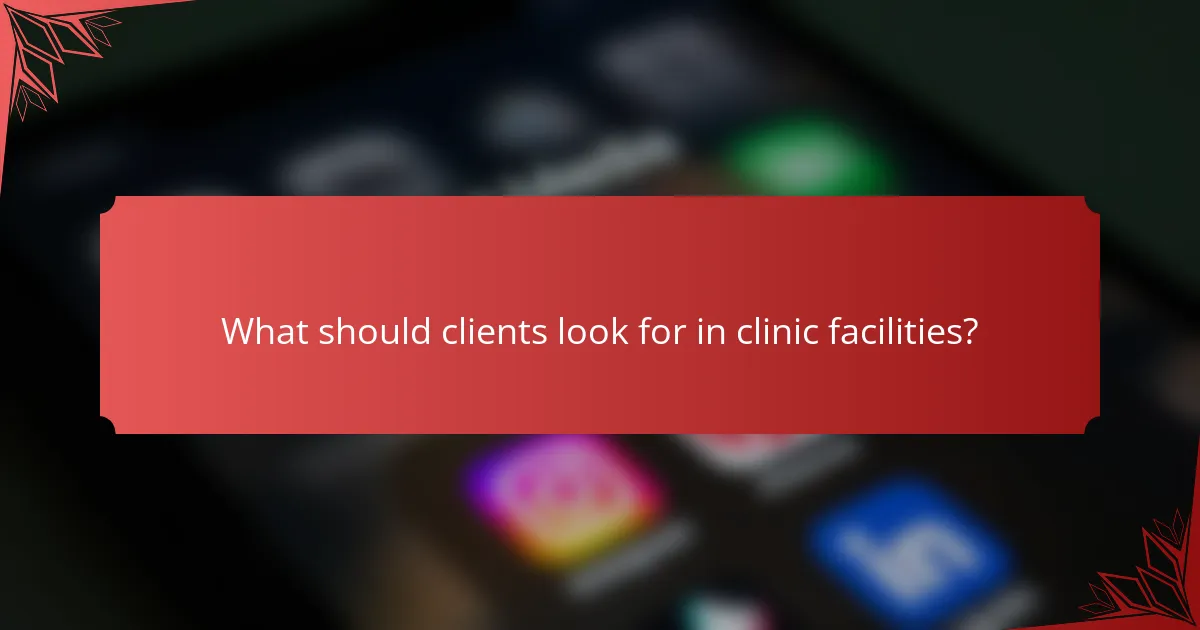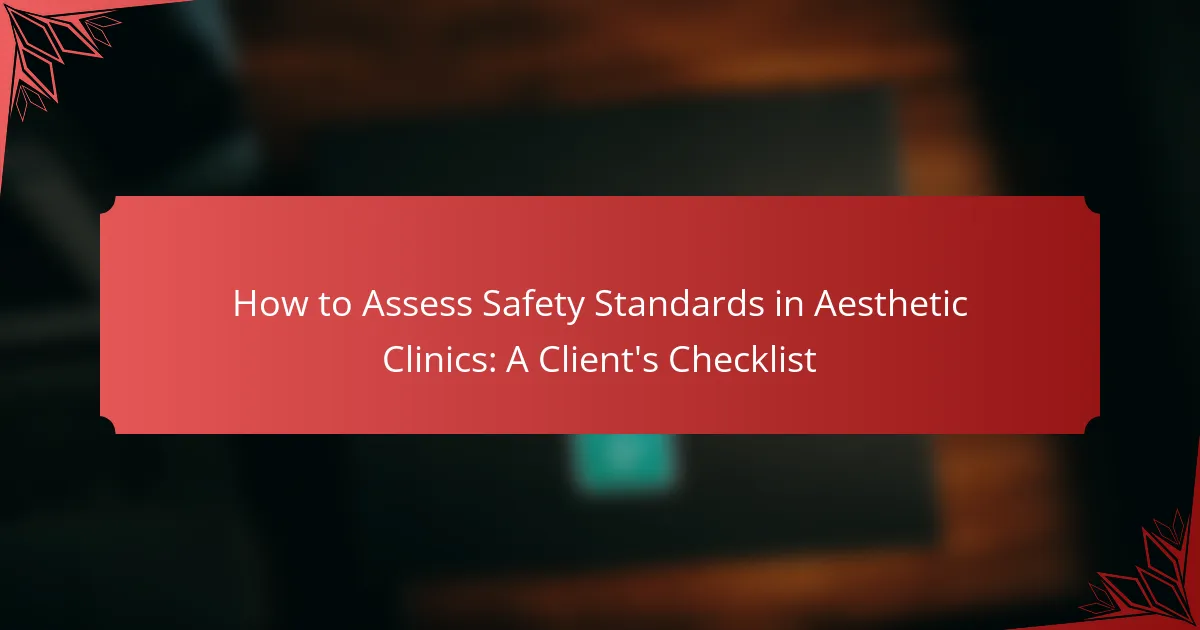When considering aesthetic treatments, it’s crucial for clients to assess the safety standards of clinics to ensure their well-being. Key factors include regulatory compliance, staff qualifications, and the use of certified medical equipment. By conducting thorough research and prioritizing cleanliness and comfort, clients can make informed decisions about their care.

What are the key safety standards for aesthetic clinics in South Africa?
Key safety standards for aesthetic clinics in South Africa focus on regulatory compliance, accreditation, the use of certified medical equipment, and the qualifications of staff. Ensuring these standards are met helps clients receive safe and effective treatments.
Regulatory compliance with the Health Professions Council of South Africa
Aesthetic clinics must comply with regulations set by the Health Professions Council of South Africa (HPCSA). This includes adhering to guidelines on the types of procedures that can be performed and ensuring that practitioners are registered and licensed.
Clients should verify that the clinic displays its HPCSA registration number prominently. This indicates that the clinic follows the necessary legal and ethical standards required for medical practices.
Accreditation by the South African Society of Aesthetic Medicine
Accreditation from the South African Society of Aesthetic Medicine (SASAM) signifies that a clinic meets specific quality and safety standards in aesthetic practices. This accreditation is a mark of credibility and professionalism.
Clients should look for clinics that are SASAM accredited, as this often means that the clinic has undergone rigorous evaluations and adheres to best practices in aesthetic medicine.
Use of certified medical equipment
Clinics must utilize certified medical equipment that meets safety and efficacy standards. This includes devices for procedures like laser treatments, injectables, and other aesthetic interventions.
Clients should inquire about the equipment used and whether it has been approved by relevant health authorities. Ensuring that equipment is regularly maintained and updated is also crucial for safety.
Staff qualifications and training requirements
The qualifications and training of staff are vital for ensuring safe aesthetic procedures. Practitioners should have appropriate medical backgrounds and specialized training in aesthetic treatments.
Clients should ask about the credentials of the staff performing procedures, including their education, certifications, and ongoing training. This helps ensure that they are receiving care from qualified professionals who are knowledgeable about the latest techniques and safety protocols.

How can clients verify the safety standards of an aesthetic clinic?
Clients can verify the safety standards of an aesthetic clinic by conducting thorough research on the clinic’s credentials, practitioner qualifications, and patient feedback. This process ensures that the clinic adheres to established safety protocols and provides quality care.
Requesting clinic accreditation documentation
One of the first steps in assessing an aesthetic clinic’s safety standards is to request documentation of its accreditation. Accredited clinics typically meet specific health and safety regulations set by recognized bodies, which can vary by country.
In the United States, for example, look for accreditation from organizations like the Joint Commission or the American Association for Accreditation of Ambulatory Surgery Facilities. In Europe, clinics may be accredited by local health authorities or similar organizations.
Checking practitioner qualifications and experience
It’s crucial to verify the qualifications and experience of the practitioners at the clinic. Ensure that they are licensed and have received specialized training in aesthetic procedures. This information can often be found on the clinic’s website or by directly asking the clinic.
Consider the practitioner’s years of experience and the number of procedures they have performed. A practitioner with several years of experience and a high volume of successful treatments is generally a safer choice.
Reviewing patient testimonials and case studies
Patient testimonials and case studies provide valuable insights into the clinic’s safety standards and overall quality of care. Look for reviews on independent platforms, as these are less likely to be filtered or manipulated by the clinic.
Pay attention to feedback regarding safety, complications, and overall satisfaction. Case studies showcasing before-and-after results can also help gauge the clinic’s effectiveness and adherence to safety protocols.

What should clients look for in clinic facilities?
Clients should prioritize safety and comfort when assessing clinic facilities. Key factors include cleanliness, availability of emergency equipment, and the privacy of consultation spaces.
Cleanliness and hygiene practices
Cleanliness is crucial in aesthetic clinics, as it directly impacts patient safety. Look for visible signs of cleanliness, such as tidy waiting areas and sanitized treatment rooms.
Inquire about the clinic’s hygiene protocols, including regular disinfection of surfaces and equipment. Clinics should adhere to local health regulations, which often dictate specific cleaning standards.
Availability of emergency medical equipment
Emergency medical equipment is essential for addressing unforeseen complications during treatments. Ensure the clinic is equipped with items like oxygen tanks, defibrillators, and first aid kits.
Ask the staff about their emergency response procedures and whether they have trained personnel available at all times. This preparedness can significantly enhance your safety during procedures.
Consultation space privacy and comfort
Privacy and comfort in consultation spaces are vital for open communication between clients and practitioners. Check if the clinic offers private rooms for consultations, allowing for candid discussions about your needs and concerns.
Comfortable seating and a welcoming atmosphere can also enhance your experience. A well-designed consultation space reflects the clinic’s commitment to client care and professionalism.

What are the risks of choosing an unaccredited aesthetic clinic?
Choosing an unaccredited aesthetic clinic poses significant risks, including increased chances of complications, limited options for recourse in case of malpractice, and the likelihood of receiving substandard treatments. These factors can lead to serious health issues and financial loss.
Increased likelihood of complications
Unaccredited clinics often lack the necessary oversight and standards, which can result in a higher incidence of complications during and after procedures. Common issues include infections, poor healing, and unsatisfactory aesthetic results. Clients should be aware that complications can lead to additional medical expenses and corrective procedures.
To mitigate these risks, clients should verify the clinic’s accreditation and the qualifications of the practitioners. Look for clinics that adhere to recognized safety protocols and have a track record of successful outcomes.
Lack of recourse for malpractice
In the event of malpractice, clients may find it challenging to seek recourse if they have chosen an unaccredited clinic. These facilities often operate outside the regulatory frameworks that protect patients, making it difficult to hold them accountable for negligence or poor practices. Legal actions against unaccredited clinics can be complicated and costly.
Before undergoing any procedure, clients should ensure that the clinic is accredited and that practitioners are licensed. This not only provides a level of assurance but also opens up avenues for legal recourse if necessary.
Potential for substandard treatments
Unaccredited clinics may offer treatments that do not meet industry standards, resulting in subpar results and increased risks. These clinics might use inferior products or outdated techniques, which can compromise the effectiveness and safety of the procedures. Clients should be cautious of deals that seem too good to be true, as they often indicate a lack of quality.
Researching the clinic’s reputation and reading reviews from previous clients can provide insights into the quality of treatments offered. Additionally, clients should inquire about the products used and the qualifications of the staff to ensure they receive safe and effective care.

How to assess practitioner experience in aesthetic procedures?
To assess a practitioner’s experience in aesthetic procedures, consider their years of practice, specialized training, and commitment to ongoing education. These factors can significantly influence the quality and safety of the treatments you receive.
Years of practice in aesthetic medicine
Evaluate how long the practitioner has been working specifically in aesthetic medicine. Ideally, look for someone with several years of experience, as this often correlates with a deeper understanding of techniques and patient care.
Practitioners with a decade or more in the field typically have encountered a wider range of cases, which can enhance their ability to handle complications or unexpected outcomes. Ask about their experience with the specific procedures you are considering.
Specialized training certifications
Check for specialized training certifications that indicate the practitioner has undergone formal education in aesthetic procedures. Certifications from recognized institutions or associations can provide assurance of their skills and knowledge.
In the U.S., for instance, look for board certification in dermatology or plastic surgery, as these credentials often require rigorous training. In Europe, similar qualifications may be recognized, such as those from the British College of Aesthetic Medicine.
Participation in ongoing education and workshops
Assess whether the practitioner actively participates in ongoing education and workshops. This commitment shows they stay updated with the latest techniques, technologies, and safety standards in the aesthetic field.
Inquire about recent workshops or conferences they have attended. Practitioners who regularly engage in professional development are more likely to provide high-quality care and incorporate new advancements into their practice.

What are the common aesthetic procedures and their safety considerations?
Common aesthetic procedures include Botox injections and dermal fillers, each with specific safety considerations. Understanding these procedures and their associated risks is crucial for clients seeking cosmetic enhancements.
Botox injections and potential side effects
Botox injections are widely used to reduce the appearance of wrinkles by temporarily paralyzing muscles. While generally considered safe, potential side effects may include bruising, swelling, and headaches. More serious complications, though rare, can involve drooping eyelids or uneven facial expressions.
Clients should ensure that the procedure is performed by a qualified professional, ideally a licensed dermatologist or plastic surgeon. It’s advisable to discuss any medical history or allergies beforehand to minimize risks.
Dermal fillers and risk of allergic reactions
Dermal fillers are used to add volume and smooth out wrinkles, but they carry a risk of allergic reactions. Common ingredients in fillers, such as hyaluronic acid, are generally safe, yet some individuals may experience redness, swelling, or lumps at the injection site.
To mitigate risks, clients should request a patch test if they have a history of allergies and choose reputable clinics that follow safety regulations. Always inquire about the filler’s composition and the provider’s experience to ensure a safe outcome.
